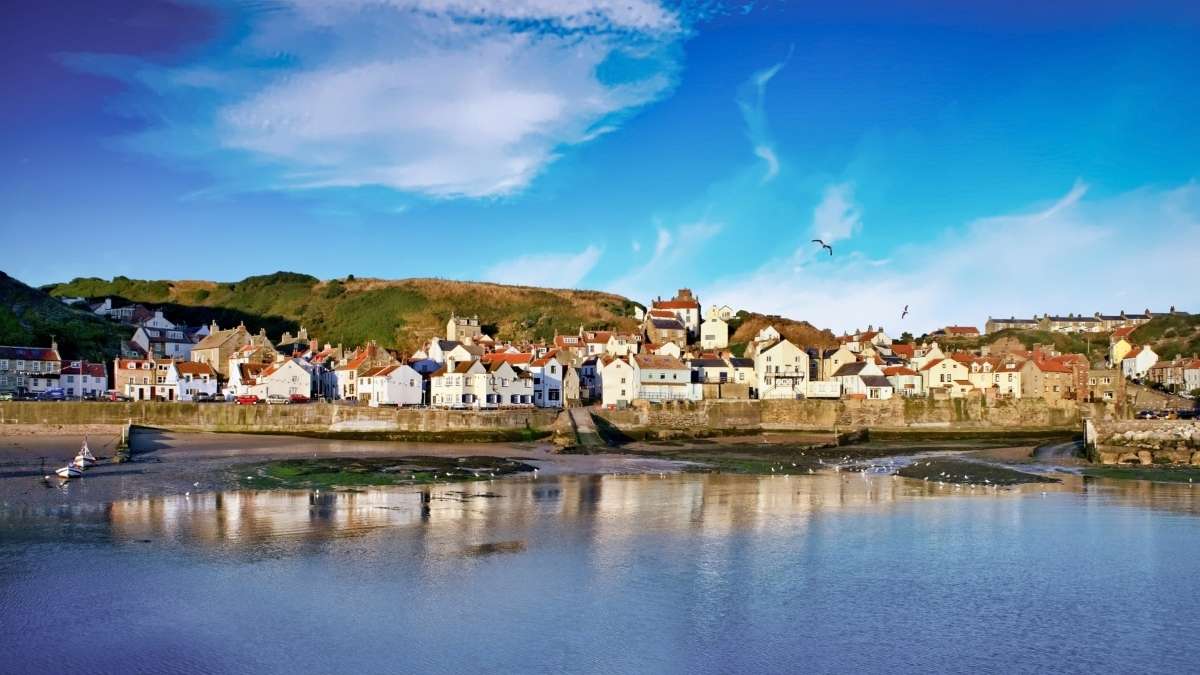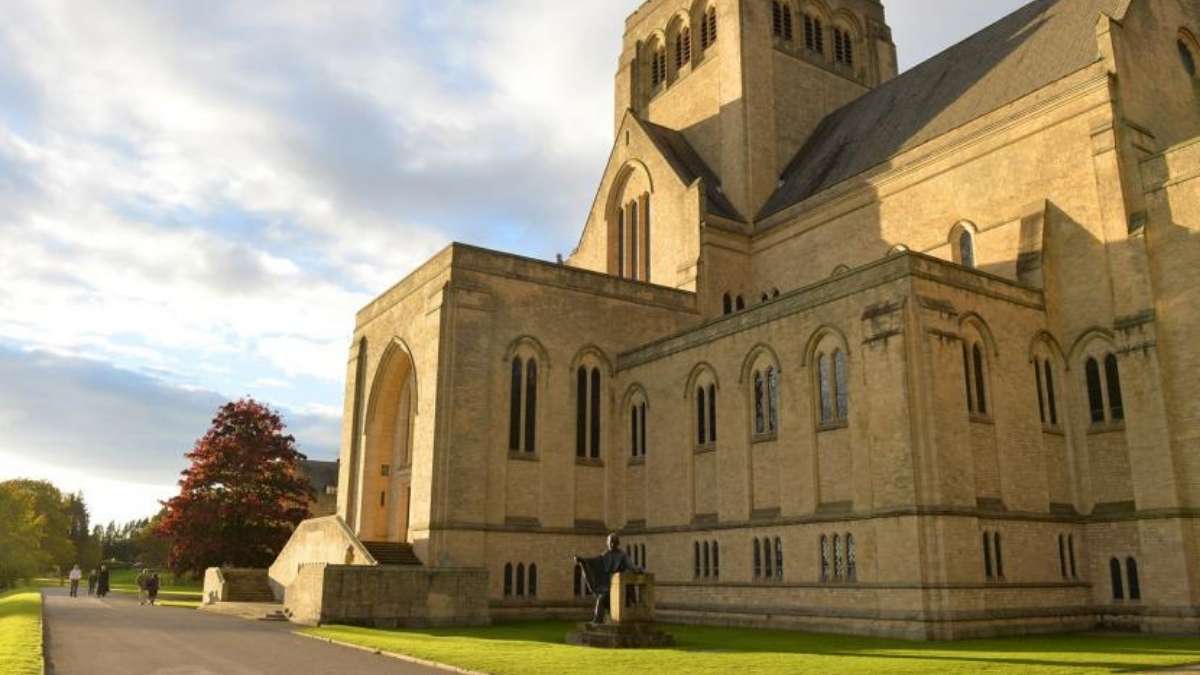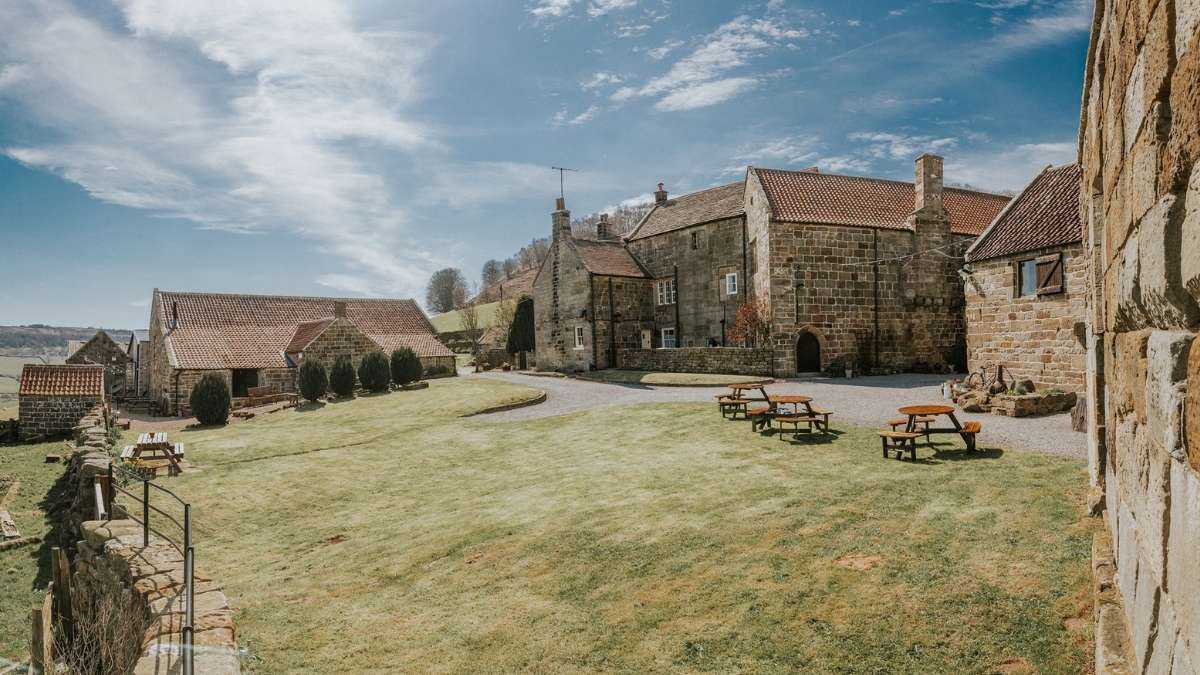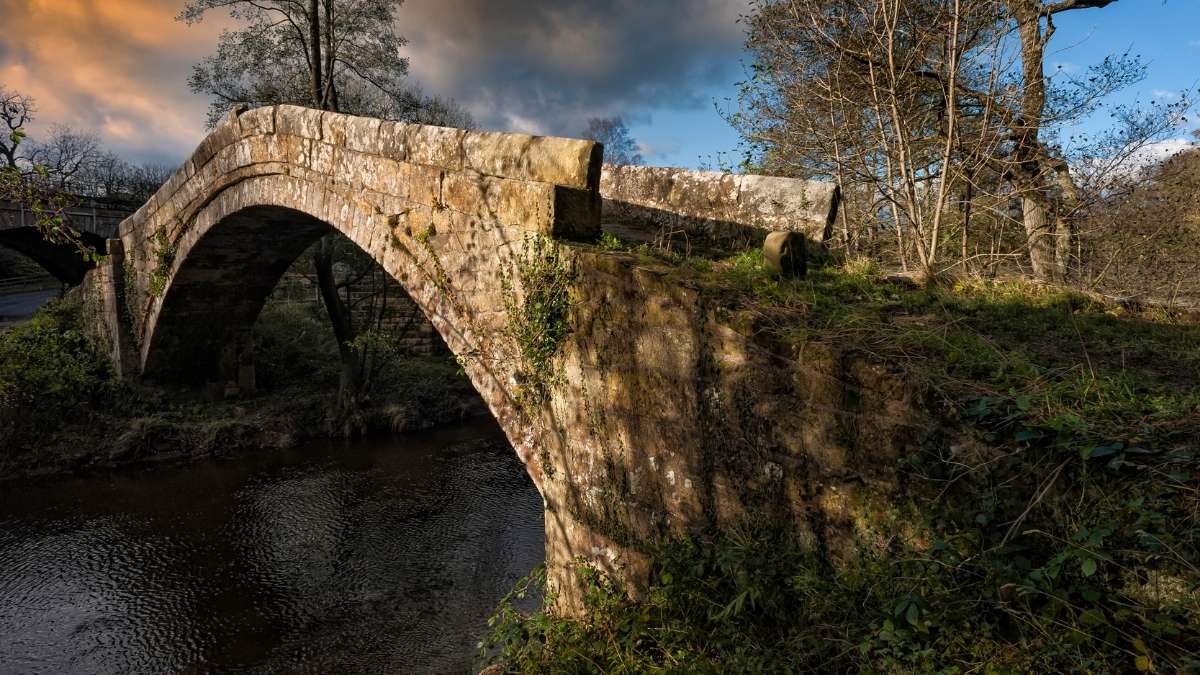The North York Moors undoubtedly has some of the most majestic and beautiful scenery and landscape you will find throughout the whole of the UK.
Wonderful countryside, however, is not all that the North York Moors has to offer. There are also many magical towns and vibrant villages just waiting to welcome you. Within them all, you will find a plethora of history and things to do and see for all the family. Here are 12 unique market towns and villages in the North York Moors.
1. Hutton Le Hole


Whitby Mini Guide
We have created a FREE mini-guide with all the essential information about Whitby, now available for instant download.
Hutton Le Hole is one of the most popular and beautiful spots within the North York Moors National Park. It is home to the Ryedale Folk Museum, Hangman’s Stone, and famous free roaming moorland sheep.
First recorded in the Domesday book as the village of Hoton, Hutton Le Hole has a charming long winding village green with a stream running down its middle. Various footbridges can be found along the stream allowing its residents to cross from one side over to the other. The village green is home to its many moorland sheep.
There are many theories about what the name Hutton Le Hole means, most likely being accepted as ‘the place near the burial mounds.’ This is due to the discovery of ancient burial mounds nearby. More details about this can be found at the Ryedale Folk Museum, which is certainly worth a visit.
Hutton Le Hole is also home to a fantastic amount of historical buildings, with no less than twenty nine having achieved grade two listing. Most of these are 18th-century constructions such as Turnpool House, built in 1782, and Potters House dating back to 1845, but there is also the 17th-century ‘pound’. This stone walled enclosure was originally used for holding lost sheep.
2. Helmsley

The only market town within the North York Moors National Park, Helmsley is not only a perfect base for exploring the surrounding areas but also a classic North Yorkshire delight. It has an open-air swimming pool, a vibrant market square, and not one but two Abbey ruins to see.
Helmsley is picture perfect and full of charm dates back to approximately 3000 BC and was initially named Elmeslac. For many years it was home to small farming communities before becoming the village it is today. Places of interest within the town include the walled gardens dating back to 1759 and the Canon’s Garth vicarage. The All Saints Church also dates back to the 12th century and contains unusual and unique one-hundred-year-old frescos.
Alternatively, if you like seeing your sights on a grander scale, there is the 900-year-old Norman castle to visit. Originally it was built as a medieval fortress but has been reincarnated several times. In Tudor times, it was a luxury mansion; during the civil war, it was a stronghold, and finally, another luxury dwelling in the Victorian period. It is now sadly a romantic Victorian ruin!
3. Goathland

The gorgeous village of Goathland has been a popular visitor attraction since the Victorian period when it was known as a spa village. Many people flocked here for the rejuvenating qualities they believed the nearby Mallyan Spout waterfall possessed.
More recently, Goathland has become better known for being the fictional village of Aidensfield in the hit TV show Heartbeat and the train station Hogsmeade in the Harry Potter films. This is not, however, all that Goathland has to offer. It has a whole lot more.
Initially built in 1896 by Mr Walter H Brierly of York, Saint Mary’s Church is an Elizabethan place of worship specifically designed to be in a bleak moorland. Mr Brierly said, ‘The qualities of simplicity, breadth and sturdiness were felt to be specially required for such a bleak moorland situation and were aimed at in the design.’
Goathland is also home to a North York Moors Railway Heritage Station from which you can travel to Grosmont. You can then take the 3.5-mile walk back to Goathland on the trail known as ‘the rail trail’, which travels down the old railway line. Once back in Goathland, why not pop to the Goathland Hotel or Aidensfield Arms, as it was known in Heartbeat.
4. Staithes

Once one of the largest fishing ports on the North-East coast, Staithes is now more commonly known as a destination for geologists and a picturesque village full of history and old-world charm. It is situated on the coast and is one of the more well-known and popular North York Moors destinations.
Situated in a sheltered harbour and bound by high cliffs and two long breakwaters, Staithes is a village full of higgledy-piggledy cottages in winding streets. It is a place lost in time where the houses do not have numbers. Instead, they are all named, it is not hard to imagine the days gone by when the now depleted but still there, colourful cobles would set sail from the mouth of Staithes Beck to start their days fishing. Or when Captain James Cook was working here as an apprentice shopkeeper before going off to seek fortune and fame. You may even see artists painting down by the harbour like the Staithes Group have consistently done over the years.
You see, modern-day Staithes has not changed and has to be the place to go if you're looking for somewhere to visit that is a taste of the old North Yorkshire. Suppose you want something a little more modern though, why not attend the Staithes Art festival when the village becomes a bustle of pop-up shops and cafes. Or try your hand at fossil hunting down on the beach. After all, you never know. You might find the next rare dinosaur-like they did in Staithes a decade ago.
5. Ampleforth

Ampleforth is home to the glorious Ampleforth Abbey, which has been home to a community of Benedictine monks seeking God since 1802. It is a magnificent place to visit if you enjoy peace and tranquility.
Originally Ampleforth was made up of just a few houses along the main road. However, you can still see examples of 19th-century construction here in the shape of the village shop and the delightful Coram Cottage.
Should you feel hungry or thirsty, there are also two pubs in this gorgeous setting, the White Swan and the White Horse. The latter is named after the large white horse carved into the hillside a few miles to the West.
If you are lucky enough to visit Ampleforth in Winter, you may catch sight of the sword dance. This was done traditionally around Christmas time and with long swords with their own back story. Legend has it that a traveller was killed by six sworders who then called a doctor to revive him. However, when the doctor gets there, he is pushed aside by a clown who proceeds to bring the man back alive by using mystical moves!
6. Rievaulx

Rievaulx is a small village close to the River Rye and built mainly from stones initially used in the building of the now ruined Rievaulx Abbey. The Abbey itself is the main tourist attraction. Built and founded in 1132 by twelve Cistercian monks, Rievaulx Abbey was intended to be a place where a strict life of prayer and self sufficiency could be made. It worked, and Rievaulx Abbey became one of the most splendid Abbeys in England up until 1538!
In 1538 Henry VIII began the dissolution of the monasteries in his attempt to release the grip of the Catholic church and create his new status as the head of the church. Rievaulx Abbey comprised over 72 buildings, housed 21 monks, and had 102 employees.
By the time Henry VIII had finished with Whitby Abbey, it was nothing but ruins. Buildings were left uninhabitable, and the whole place was stripped of anything with worth. The Abbey itself was left to fall into the ruins we see today. It is now owned and run by English Heritage.
7. Thornton Le Dale

Thornton Le Dale is the quintessential chocolate box village you see depicted on calendars and boxes of Yorkshire fudge! It is full of independent shops, cafes, pubs, and tearooms for you to enjoy.
Thornton Le Dale is home to a babbling brook and Beck Isle Cottage, centred on a tiny triangular green with an old market cross and stocks. This cottage, as mentioned above, is featured on countless chocolate boxes and calendars and is the most loved sight in the village. Incidentally, the town has been named Yorkshire’s prettiest in a newspaper poll.
If you tire of the village, the nearby Dalby Forest offers walking, cycling, nature, and stargazing. There are also lots of woodland walks and nature trails even closer by. Go Ape is another option if you feel adventurous and fancy zip lining through the trees.
Thornton Le Dale also holds annual events such as Christmas light switch-ons, spring galas, flower shows, scarecrow festivals, harvest festivals, and village plays.
8. Danby

Danby is a bustling moorland village that lies in the Esk Valley just half a mile from the North York Moors National Park. It has great walking countryside surrounding it and a magnificent castle. Built in the 14th century for Lord Latimer as a sign of his great wealth Danby Castle was created with both defence and comfort in mind. It is now a wedding venue and farm famed for Catherine Parr living there before her marriage to Henry VIII.
Also close by are the Danby beacons that date back to the 1600s when the country was living under the threat of invasion by France. They would be lit should the soldier on duty see any sign of a foreign fleet. Nowadays they are a popular landmark that were rebuilt in 2008 and are used as waymarkers for walkers.
To learn more about Danby and other North York Moors villages you should head for the Moors National Park Centre where they hold history and information on them. Here you can also picnic in the beautiful grounds, explore wood-boggle houses, walk woodland trails, and purchase local crafts.
9. Grosmont

Pronounced ‘growmont,' Grosmont was once a hive of industry in the ironstone trade. Nowadays, however, it is more of a peaceful haven to get away from it all. After visiting the village's historic sites, there are several cafes and pubs to relax in.
Grosmont is home to another priory Henry VIII dissolved during his tirade against the Catholic church. It is also the place where the North York Moors and Esk Valley railways meet. The railway dominates this village and is home to the North York Moors Railway engine shed.
Also, the village has some significant historic buildings, including the 19th-century Esk Villa, Rose Cottage, The Station Tavern Public House, and the post office dating back to 1835. All of these are well worth a visit.
If you care for a little walk whilst visiting Grosmont, we recommend the 3.5-mile rail trail that runs along Stephensons' original railway line from Grosmont via Beck Hole and Goathland. If you're lucky enough to be there in May, the local woods has a fabulous display of bluebells.
10. Fylingdales

Although not situated in Fylingdales itself, this North York Moors village's name is probably best known for the intriguing RAF base which carries its name. Fylingdales is a small village just inland from the old smugglers' port of Robin Hood's Bay. The RAF site is located on the A169 moors road between Whitby and Pickering and houses a ballistic early warning system. It is the former home of three famous geodesic dome-shaped balls.
The village's history dates back to the 14th century when a group of monks maintained a lime kiln. The Abbot of Whitby owned a park and woodland in the area, a mill, and Fyling Old Hall. This could be why, in 1821, a beautiful church was built here that still stands today.
St. Stephens Church is a popular tourist attraction with its 19th-century box pews and triple-decker pulpit. There is also a poignant reminder of the sea faring history with memorials inside the church and in the graveyard to those lost at sea. A second church was later built in 1868, closer to the village centre.
11. Glaisdale

Glaisdale is a quaint, scenic village situated on the Esk Valley Railway. It is full of character, with terraces of slate-roofed houses initially built to house stone miners and workers within the iron ore industry.
Walking is very popular in this quiet village, with many visitors visiting Beggars Bridge at the eastern end. This is due to the somewhat romantic tale attached to it. It is situated just one mile from the village, where the road drops steeply down into a rich wooded valley. The story goes that Thomas Ferres, the son of an impoverished Glaisdale farmer, had to wade across the river to see the love of his life, Agnes. She was the daughter of a local squire who, unfortunately, disapproved of their courtship. To get the squire's approval, Thomas left to seek his fortune, which he did. He first became Sheriff and then later the Mayor of Hull.
Unsurprisingly when he returned to Glaisdale, he claimed his bride and married Agnes, and they lived happily ever after. But, sadly, all good things end, and when Agnes died, Thomas built a bridge across the river he had once waded through to reach his love. This bridge later became known as the Beggars Bridge and is visited by many tourists. It has the date 1619 engraved on it and the initials TF.
12. Robin Hood's Bay

Surrounded by myths and legends, Robin Hood's Bay is a magical fishing village on the Heritage Coast of the North York Moors. It's a beautiful place to visit with family and especially children. Wander through the winding streets and alleyways, play on the beach, explore the rock pools, search for fossils, and relax with a drink and a view. We recommend the Bay Hotel.
There are plenty of walks nearby, and the Cinder Track is easily accessed from here if you fancy walking through to Whitby. With easy access to both Whitby and Scarborough, together with other parts of the stunning North York Moors National Park and Heritage Coast, where better to stay for a short break or a more extended holiday.
Let us know how many of these unique market towns and villages in the North York Moors you have visited or if you have added any of our suggestions to your list in the comments.









Related Posts